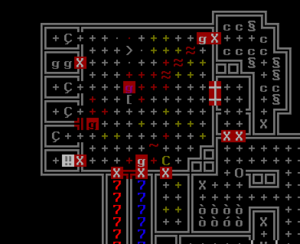- v50 information can now be added to pages in the main namespace. v0.47 information can still be found in the DF2014 namespace. See here for more details on the new versioning policy.
- Use this page to report any issues related to the migration.
Difference between revisions of "v0.31:Floodgate"
(Rated article "Exceptional" using the rating script) |
|||
| Line 1: | Line 1: | ||
| − | {{ | + | {{quality|Exceptional|08:00, 22 May 2010 (UTC)}}{{av}} |
| − | {{ | + | |
A '''floodgate''' is a gate which allows the control of the flow of liquids such as {{l|water}} or {{l|magma}}. They are operated by mechanisms such as {{l|lever}}s or {{l|pressure plate}}s which open and close them. When closed they behave like walls, but allow liquids, objects, and creatures to pass over them when opened. | A '''floodgate''' is a gate which allows the control of the flow of liquids such as {{l|water}} or {{l|magma}}. They are operated by mechanisms such as {{l|lever}}s or {{l|pressure plate}}s which open and close them. When closed they behave like walls, but allow liquids, objects, and creatures to pass over them when opened. | ||
Revision as of 09:39, 7 June 2010
| This article is about an older version of DF. |
A floodgate is a gate which allows the control of the flow of liquids such as Template:L or Template:L. They are operated by mechanisms such as Template:Ls or Template:Ls which open and close them. When closed they behave like walls, but allow liquids, objects, and creatures to pass over them when opened.
They can be manufactured from Template:L (at a Template:L), Template:L (at a Template:L), Template:L (at a Template:L), or Template:L (at a Template:L). Once manufactured, they are built in the desired location using the keys b, x.
Uses
Floodgates are used to control the flow of liquid. Because of the Template:L of certain liquids and the Template:L posed by others, floodgates have a wide range of applications in any dwarven settlement.
They are instrumental in controlled Template:L for Template:Ling, or controlled Template:Ling for Template:L Template:L Template:L.
Placement
Floodgates are constructed Template:Lly on a solid, Template:L floor in the 'closed' position (note that this means it is possible for careless dwarves to trap themselves on the wrong side of the gate). A Template:L must then link up a Template:L or other triggering mechanism to the floodgate. This requires two Template:Ls; the mechanic will haul one mechanism to the trigger, work for awhile, and then haul the other mechanism to the floodgate to complete the task.[Verify]
Activation
Once the lever is pulled, the floodgate will open. When the lever is pulled again, the floodgate will close. This will destroy (not displace) any liquid occupying the same tile as the floodgate. Objects on the floodgate's tile, however, cannot be destroyed this way - in fact, the floodgate will refuse to close. Any object, everything from swords to socks to stones to scorpion corpses, can jam the floodgate this way. Once the object is removed, however, the floodgate will grind shut by itself.[Verify]
Magma Control
Floodgates will resist magma when closed, just as a constructed wall would, but when opened will be destroyed if they are not made from Template:L. The mechanisms used in the construction of the floodgate must also be magma-safe to prevent this.[Verify]
| Rooms |
Barracks • Bedroom • Dining room • Dormitory • Jail • Meeting hall • Hospital • Office • Sculpture garden • Tomb • Zoo |
|---|---|
| Furniture |
Animal trap • Anvil • Armor stand • Bed • Bin • Box • Bucket • Cabinet • Cage • Coffin • Restraint • Seat • Statue • Table • Weapon rack |
| Access | |
| Constructions | |
| Machine & Trap parts |
Axle • Gear assembly • Millstone • Screw pump • Water wheel • Windmill • Lever • Pressure plate • Trap • Support |
| Other Buildings | |
| Related Articles | |
